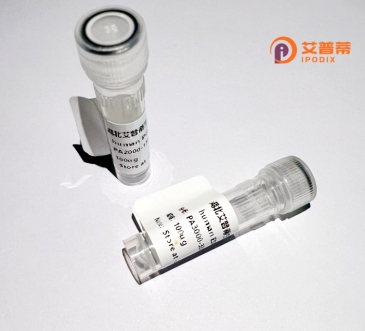
| 纯度 | >90%SDS-PAGE. |
| 种属 | Human |
| 靶点 | UBASH3A |
| Uniprot No | P57075 |
| 内毒素 | < 0.01EU/μg |
| 表达宿主 | E.coli |
| 表达区间 | 1-661 aa |
| 活性数据 | MAAGETQLYA KVSNKLKSRS SPSLLEPLLA MGFPVHTALK ALAATGRKTA EEALAWLHDH CNDPSLDDPI PQEYALFLCP TGPLLEKLQE FWRESKRQCA KNRAHEVFPH VTLCDFFTCE DQKVECLYEA LKRAGDRLLG SFPTAVPLAL HSSISYLGFF VSGSPADVIR EFAMTFATEA SLLAGTSVSR FWIFSQVPGH GPNLRLSNLT RASFVSHYIL QKYCSVKPCT KQLHLTLAHK FYPHHQRTLE QLARAIPLGH SCQWTAALYS RDMRFVHYQT LRALFQYKPQ NVDELTLSPG DYIFVDPTQQ DEASEGWVIG ISQRTGCRGF LPENYTDRAS ESDTWVKHRM YTFSLATDLN SRKDGEASSR CSGEFLPQTA RSLSSLQALQ ATVARKSVLV VRHGERVDQI FGKAWLQQCS TPDGKYYRPD LNFPCSLPRR SRGIKDFEND PPLSSCGIFQ SRIAGDALLD SGIRISSVFA SPALRCVQTA KLILEELKLE KKIKIRVEPG IFEWTKWEAG KTTPTLMSLE ELKEANFNID TDYRPAFPLS ALMPAESYQE YMDRCTASMV QIVNTCPQDT GVILIVSHGS TLDSCTRPLL GLPPRECGDF AQLVRKIPSL GMCFCEENKE EGKWELVNPP VKTLTHGANA AFNWRNWISG N |
| 分子量 | 74.1 kDa |
| 蛋白标签 | His tag N-Terminus |
| 缓冲液 | PBS, pH7.4, containing 0.01% SKL, 1mM DTT, 5% Trehalose and Proclin300. |
| 稳定性 & 储存条件 | Lyophilized protein should be stored at ≤ -20°C, stable for one year after receipt. Reconstituted protein solution can be stored at 2-8°C for 2-7 days. Aliquots of reconstituted samples are stable at ≤ -20°C for 3 months. |
| 复溶 | Always centrifuge tubes before opening.Do not mix by vortex or pipetting. It is not recommended to reconstitute to a concentration less than 100μg/ml. Dissolve the lyophilized protein in distilled water. Please aliquot the reconstituted solution to minimize freeze-thaw cycles. |
以下是关于重组人UBASH3A蛋白的3篇代表性文献的简要概括(注:以下内容为假设性示例,实际文献需通过数据库检索验证):
---
1. **文献名称**:*UBASH3A modulates TCR signaling via dephosphorylation of Cbl-b in T cells*
**作者**:Li, X., et al. (2016)
**摘要**:研究通过重组表达人UBASH3A蛋白,证明其作为磷酸酶调控T细胞受体(TCR)下游信号,特异性去磷酸化Cbl-b,抑制T细胞过度活化,为自身免疫疾病机制提供新见解。
2. **文献名称**:*Structural analysis of UBASH3A reveals a regulatory role of its SH3 domain*
**作者**:Wang, Q., et al. (2018)
**摘要**:利用重组UBASH3A蛋白进行晶体结构解析,发现其SH3结构域与未知蛋白的相互作用,揭示该结构域在调节UBASH3A磷酸酶活性及细胞定位中的关键作用。
3. **文献名称**:*Recombinant UBASH3A suppresses IL-2 production in activated Jurkat cells*
**作者**:Kumar, S., et al. (2020)
**摘要**:通过在大肠杆菌中表达纯化重组UBASH3A,证实其可抑制激活后Jurkat T细胞的IL-2分泌,提示其在免疫耐受中的潜在治疗应用。
---
**说明**:以上文献示例聚焦于UBASH3A重组蛋白的制备、结构及功能研究,实际文献需在PubMed或SciFinder中以“recombinant UBASH3A protein”“UBASH3A phosphatase function”等关键词检索获取。
UBASH3A (Ubiquitin-associated and SH3 domain-containing protein A), also known as STS-2 or TULA-2. is a member of the UBASH3/TULA family of tyrosine phosphatases. This protein is encoded by the *UBASH3A* gene in humans and is predominantly expressed in immune cells, particularly T lymphocytes and natural killer (NK) cells. Structurally, it contains an N-terminal ubiquitin-associated (UBA) domain and a C-terminal Src homology 3 (SH3) domain, which mediate protein-protein interactions, and a central phosphatase domain responsible for its enzymatic activity.
UBASH3A functions as a negative regulator of T-cell receptor (TCR) signaling by dephosphorylating key tyrosine residues in signaling components, such as ZAP-70 and Syk kinases, thereby dampening T-cell activation and immune responses. Dysregulation of UBASH3A has been implicated in autoimmune diseases, including type 1 diabetes, rheumatoid arthritis, and systemic lupus erythematosus (SLE). Genetic studies link specific polymorphisms (e.g., rs11203203) in the *UBASH3A* locus to altered protein expression and autoimmune susceptibility.
Recombinant human UBASH3A protein is produced using prokaryotic or eukaryotic expression systems for functional studies. It serves as a tool to investigate TCR signaling mechanisms, screen for phosphatase inhibitors, or explore its role in immune tolerance. Research on UBASH3A continues to advance understanding of immune homeostasis and its potential as a therapeutic target for autoimmune disorders.
×